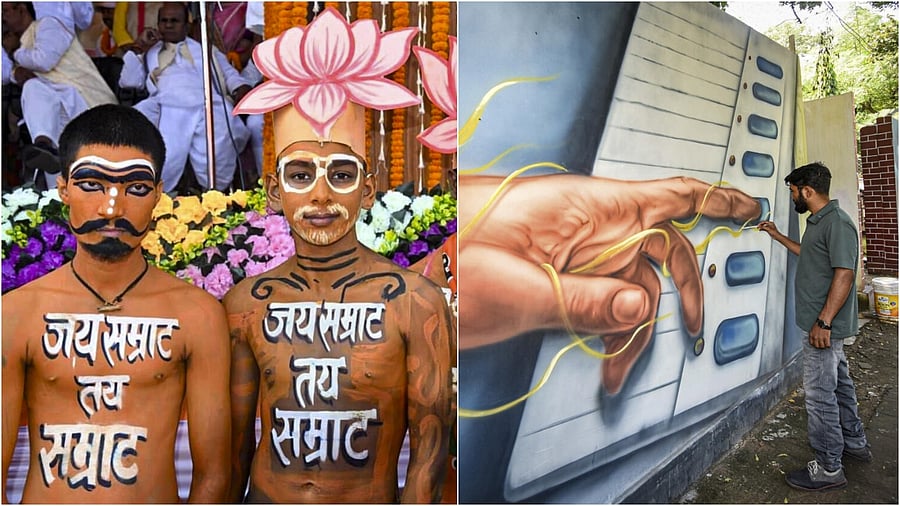
There are few secrets in Bihar politics, but few as open as the one that Nitish Kumar does not remain the authoritative undisputed NDA leader of yore.
Credit: PTI Photos
Indian academic and political analyst Manisha Priyam, in a recent conversation with this author, asserted that the election campaign for the impending Bihar Assembly polls started in January 2024, with the Centre announcing that former Chief Minister Karpoori Thakur was being posthumously bestowed with Bharat Ratna.
The contention is not off the mark. The decision was unmistakably a ploy on the part of the Bharatiya Janata Party (read Prime Minister Narendra Modi) to publicise its ‘recognition’ of the contributions of society’s weakest and most marginal members.
Thakur, who passed away in 1988, was Bihar’s first non-Congress chief minister despite being born to the family of a marginal farmer from Nai (barber) community, a caste, formally part of the Most Backward Castes (MBCs) within the larger community of Other Backward Castes (OBCs).
The BJP needed the support of this section’s voters in last year’s parliamentary polls and is banking on them again in the effort to maintain its winning streak (the BJP-led National Democratic Alliance (NDA) won 30 of the 40 Lok Sabha seats in Bihar).
But, barring during the anti-Emergency stir and briefly in the late 1960s, there was little in common between the Sangh parivar and Thakur. When he notched his most notable ‘achievement’ — appointing the Mungeri Lal Commission in 1977 immediately after embarking on his second tenure as chief minister, which eventually recommended reclassifying backward classes into extremely backward classes (including weaker sections of Muslims) and backward classes, the BJP in its previous avatar as Bharatiya Jana Sangh, essentially comprised and was primarily wedded to the interests of upper castes — the Brahmin-Bania combine.
For almost the entire 36 years between the announcement of the award (2024), and when Thakur died, there could not have been two political entities which were more apart than those which advocated his worldview, and the proponents of Hindutva. But, last year’s announcement indicated that the BJP has initiated the process of completing one circle or phase of Indian politics.
Twenty-one months later, as the campaign prepares to shift gears with the successive festivals of Diwali and Chhath, which ensure that even the most reluctant of migrant workers from Bihar, return home, this election appears to herald the end of an epoch in the state.
Developments here always provided impetus to the national politics. Mahatma Gandhi became a national figure after the Champaran Satyagraha and the freedom struggle took a new turn. The first stirrings against Indira Gandhi’s policy failure may have been staged by Gujarat’s students, but it was Jayaprakash Narayan’s call for Total Revolution from Bihar that electrified India.
The agitation against Emergency ushered in the first phase of social justice policies and politics with Thakur’s decision of a 26% sub-categorised reservation system in government services for the MBCs. More importantly, the agitation against Indira Gandhi’s draconian measures threw up a new generation of political leadership which carries the beacon of social justice to this date.
Besides established leaders like Thakur and Jagjivan Ram, whose decision to ‘desert’ the Congress catalysed its defeat to the Janata conglomerate in 1977, that chapter introduced leaders like Lalu Prasad, Ram Vilas Paswan, Nitish Kumar, Geroge Fernandes (although not from Bihar, he contested the Lok Sabha polls from here and was embraced by its people till his last days), Sushil Modi, Ravi Shankar Prasad, and so on.
Importantly, although from divergent anti-Congress streams, they shared dreams during the ‘Janata days’, but eventually chose separate pathways.
Almost 50 years later, while some like Paswan and Sushil Modi have breathed their last, others like Kumar and Prasad are feeble images of past charismatic selves. It is not yet clear how many of their ideas prevail within their parties, but at least the latter’s ‘successor’, son Tejashwi Yadav, does not yet convey that his writ runs large. When that situation arises, he will have to demonstrate that his collegiality is nowhere lower than his father’s, at least with those who remained members of Team Lalu.
There are few secrets in Bihar politics, but few as open as the one that Nitish Kumar does not remain the authoritative undisputed NDA leader of yore. Yet, he remains relevant because the people of Bihar do not discard icons they’ve embraced. Even after more than 75 years, love and admiration for Gandhi forced political newbie Prashant Kishor to give his outfit, yet to evolve as a party in the public eye, a name that mirrors Gandhi's call for swaraj.
To add to the race for votes for the most marginalised and impoverished with new ‘lures’, the decision to ‘refresh’ the electoral rolls with a three-lettered coinage — SIR, too, joins the list of ‘issues’ which will likely determine voters’ choice. Identity remains Bihar’s basic unit of recognition. Caste-based calculations are common for all polls, especially here. But there is a realm beyond this, poignantly realised by homeward-bound long-marchers during Covid-19, and ceaseless discussions within and across communities regarding urban experiences.
As an older generation of leaders either fights for relevance or prepares to step aside, this election will determine whether their brand of politics continues to shape Bihar’s future — or if a BJP-led ‘new politics’ emerges, based on a formulation, at least for Bihar, that is different from its past.
Disclaimer: The views expressed above are the author's own. They do not necessarily reflect the views of DH.
Nilanjan Mukhopadhyay is a journalist and author of ‘Narendra Modi: The Man, The Times’ and ‘The RSS: Icons of the Indian Right’. X: @NilanjanUdwin